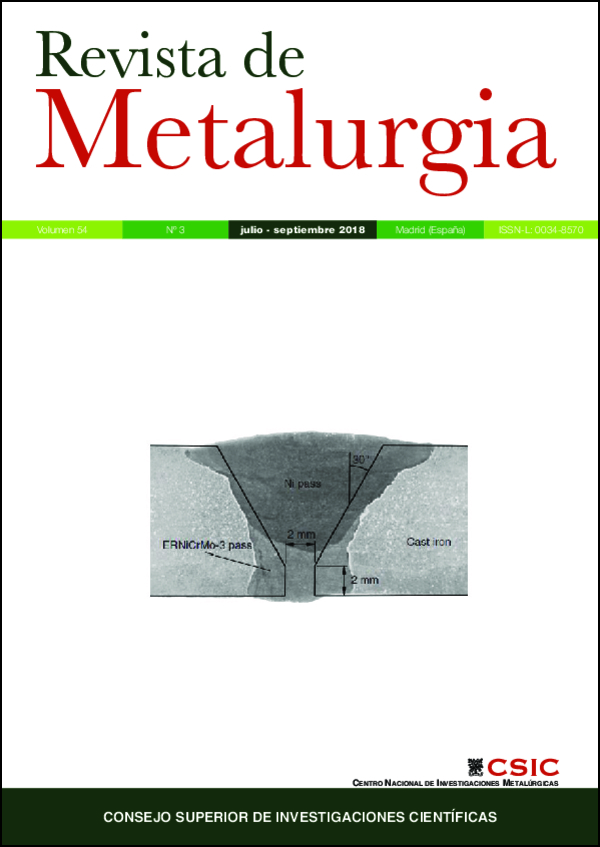A common and concise formats approach to a Key-Curve construction for generating crack extension data in C(T) specimens
DOI:
https://doi.org/10.3989/revmetalm.123Keywords:
Common format, Crack growth law, Fracture toughnes, J-R Curve, Stable crack extensionAbstract
The construction of a J-R curve for a ductile material following Standard ASTM E 1820-15 (2015) requires information on the stable crack extension process. According to E1820, the resistance curve may be obtained from a single specimen test, in which the crack size is measured simultaneously with force and displacement by the unloading compliance, potential drop, or normalization procedures. Based upon the Common and Concise Formats, Donoso and Landes developed the “crack growth law” and the “intercept method” as an alternative to obtain crack sizes in a test that shows stable crack extension, but have only force-displacement data and the initial and final crack sizes available. These alternative methods are now supplemented by an improved key-curve construction based on these formats, and are applied to C(T) test data in which the crack extension values are insufficient to produce a valid J-R curve.
Downloads
References
Andrews, W.R. (1985). Determining crack extension using a displacement based key curve method. Elastic-Plastic Fracture Test Methods: The User´s Experience. (ASTM STP856), E.T. Wessel, F.J. Loss, Eds., ASTM International, West Conshohocken, PA. USA, pp. 308–321. https://doi.org/10.1520/STP34532S
ASTM E1820-15 (2015). Standard test method for measurement of fracture toughness. ASTM International, West Conshohocken, PA. USA.
Candra, H., Wright, W.J., Albrecht, P. (2002). Experimentally determined key curves for fracture specimens. Int. J. Fract. 117 (3), 247-267. https://doi.org/10.1023/A:1022007616892
De Barbieri, F. (2014). The effects of mechanical twinning on the fracture toughness of a TWIP steel. (in Spanish), D.Sc. Thesis, Universidad de Santiago de Chile, Santiago, Chile.
Donoso, J.R., Landes, J.D. (1994). Common Format for developing calibration curves in elastic-plastic fracture mechanics. Eng. Fract. Mech. 47 (5), 619-628. https://doi.org/10.1016/0013-7944(94)90153-8
Donoso, J.R., Landes, J.D. (2001). Advantages of the concise K and compliance formats in fracture mechanics calculations. Fatigue and Fracture Mechanics. (ASTM STP1406), 32nd Volume, R. Chona, Eds., ASTM International, West Conshohocken, PA, pp. 261–278.
Donoso, J.R., Landes, J.D. (2010). Use of the intercept method for J-R curve construction of C(T) specimens without crack extension data. European Conference on Fracture (ECF) 18, Paper 311. http://www.gruppofrattura.it/ocs/index. php/esis/ECF18/paper/viewFile/6370/2231.
Donoso, J.R., Zahr, J., Landes, J.D. (2005a). Construction of J-R Curves using the Common and Concise Formats. ASTM International 2 (3), 1-17.
Donoso, J.R., Zahr, J., Landes, J.D. (2005b). A new methodology for the evaluation of the J-R curve, Rev. Metal. 41 (6), 419-426. https://doi.org/10.3989/revmetalm.2005.v41.i6.233
Donoso, J.R., Vásquez, K., Landes, J.D. (2008). The Significance of a Crack Growth Law for a C(T) fracture specimen undergoing stable crack extension. ASTM International 5 (10), 1-15.
Donoso, J.R., Leiva, R., Labbé, F. (2009). Experimental and numerical analysis of the intercept method for evaluating stable crack extension in a steel C(T) specimen. Rev. Metal. 45 (5), 325-333. https://doi.org/10.3989/revmetalm.0809
Emrich, A., Mühlich, U., Kuna, M., Ludwig, A., Trubitz P. (2007). Indirect measuring of crack growth by means of a key-curve-method in pre-cracked Charpy specimens made of nodular cast iron. Int. J. Fract. 145 (1), 47–61. https://doi.org/10.1007/s10704-007-9105-2
Joyce, J.A. (1983). Static and dynamic J-R curve testing of A533B steel using the Key Curve analysis technique. In Fracture Mechanics. Vol. I: Theory and Analysis. Fourteenth Symposium, J.C. Lewis, G. Sines, Eds., ASTM International, West Conshohocken, PA, pp. 543-560.
Joyce, J.A., Albrecht, P., Tjiang, H.C., Wright, W.J. (2001). Compliance ratio method of estimating crack length in dynamic fracture toughness tests. Fatigue and Fracture Mechanics. (ASTM STP791), 32nd Volume, R. Chona, Ed., ASTM International, West Conshohocken, PA, pp. 139-157.
Pehrson, B.P., Landes, J.D. (2006). A direct estimate of JIc from the load versus load-line displacement record. Fatigue Fract. Eng. Mater. Struct. 30 (2), 73–86. https://doi.org/10.1111/j.1460-2695.2006.01046.x
Zhu, X.-K., Joyce, J.A. (2012). Review of fracture toughness (G, K, J, CTOD, CTOA) testing and standardization. Eng. Fract. Mech. 85, 1–46. https://doi.org/10.1016/j.engfracmech.2012.02.001
Published
How to Cite
Issue
Section
License
Copyright (c) 2018 Consejo Superior de Investigaciones Científicas (CSIC)

This work is licensed under a Creative Commons Attribution 4.0 International License.
© CSIC. Manuscripts published in both the printed and online versions of this Journal are the property of Consejo Superior de Investigaciones Científicas, and quoting this source is a requirement for any partial or full reproduction.
All contents of this electronic edition, except where otherwise noted, are distributed under a “Creative Commons Attribution 4.0 International” (CC BY 4.0) License. You may read the basic information and the legal text of the license. The indication of the CC BY 4.0 License must be expressly stated in this way when necessary.
Self-archiving in repositories, personal webpages or similar, of any version other than the published by the Editor, is not allowed.
















